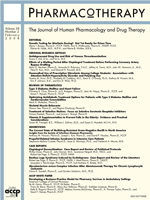
The recently released Institute for Scientific Information (ISI) Impact rankings show that Pharmacotherapy has risen above 2.00 (specifically, 2.012), surpassing both the Annals of Pharmacotherapy (1.985) and the American Journal of Health-System Pharmacists (AJHP; 1.708). The Board of Directors (BOD) and Scientific Editor Council (SEC) review strategies on an ongoing basis to improve journal quality and its impact on the field of pharmacotherapy. One factor that is monitored to assess impact and quality is the ISI Impact Factor. For the past couple of years, the SEC has increased the rejection rate of papers submitted to the journal in an effort to reduce the number of papers that do not significantly contribute to evidenced-based pharmacotherapy or clinical research. Although one cannot determine precisely what increased the impact factor for 2007, it is likely that the increase is, in part, because of the heightened rejection rate fostered by the journal’s scientific editors. This year, the SEC has recommended the following initiatives to further increase the quality of the journal:
- Set word limits for articles and abstracts.
- Condense the number of departments of the journal.
- Revise the review process to reject papers that do not add significantly to the field of pharmacotherapy.
- Increase the number of invited editorials.
- Increase the number of invited review papers.
- Publish issues of the journal that focus on current issues in specific areas of pharmacotherapy.
These initiatives are currently at various stages of implementation. The SEC and the BOD remain hopeful that these and other initiatives will lead to further improvements in the quality of the journal and increase the impact factor. More information about these and other initiatives will appear in forthcoming issues of this newsletter and in the journal. We thank all of you who have served the journal in so many capacities.